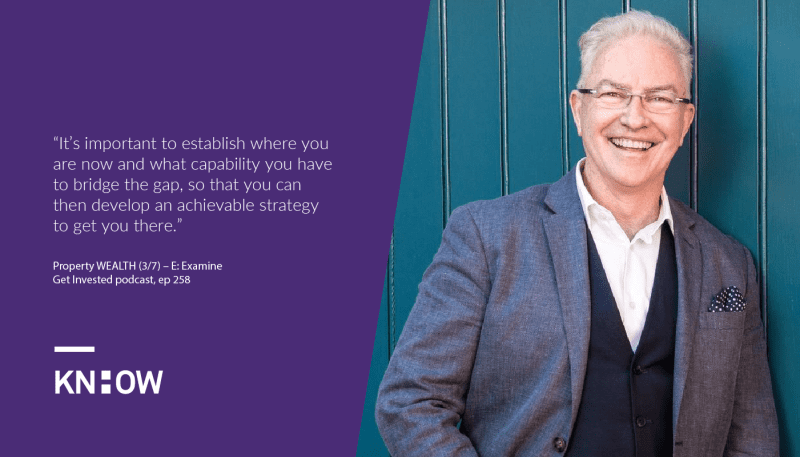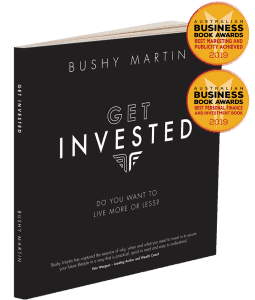KnowHow founder Bushy Martin reveals how to examine your investment capabilities by breaking down the BEAR facts – Borrow, Equity, Affordability and Risk.
In the third episode of the special Property WEALTH Get Invested podcast series, Bushy talked about examining how much you’re able to spend on an investment property, how much it’s going to cost you to hold it, and how you can minimise any risks, by covering the ‘BEAR facts’.
B for Borrow: How much can you borrow for your investment property?
There are many elements to consider when borrowing money for your investment property, such as interest rates, valuations, offset accounts, self-funding structures, standalone loans, and mortgage brokers.
However, Bushy said the biggest thing to focus on is the ability to maximise your borrowing capacity to secure a higher property asset value as soon as possible. This is achieved by chasing your maximum reach, rather than the lowest rate.
“When it comes to finance, most borrowers, most banks and most brokers only focus on one thing – chasing the lowest interest rate on the loan. But they’re missing the point – as an investor, what’s your biggest lending asset? It’s not rate but reach,” Bushy explained.
“There’s a 50-60% variation across the 40 odd lenders and over 2,000 loan solutions on how much you can lend, based on exactly the same income and liabilities position. This is the difference between being able to secure a $500k property versus a $750k to $800k property, because the more you can affordably borrow, the quicker and larger the potential property asset base you can secure, and the greater your projected net worth will be.
“And in 20 years time, this initial $300k difference will have increased to accumulating an extra $1.16M in equity value, based on an average 7% capital growth rate – which is a whopping 60% increase – just because you went with a bank that allows you to borrow 50-60% more. And this is important, because it’s the size of your nest egg that will determine how much passive income you’ll enjoy to fund your ideal lifestyle.”
E for Equity: How much equity or savings do you have?
Bushy explained how equity is just as important as borrowing capacity, as it’s the lower of the two that determines how much property you can actually secure.
“There’s no point being able to borrow $2M if you have no equity to cover the minimum 10% loan shortfall, plus 5-10% property purchase on costs. Conversely, there’s no point having a lot of available equity in your home if you’re not able to borrow much due to your income and liabilities situation,” he said.
“For example, self-employed borrowers often get into strife in relation to borrowing capacity because they may be earning good money, but if they have a good accountant who minimises their gross declared taxable income via deductions and other mechanisms, then they may not be able to borrow the funds necessary to invest in property.
“So you need a reasonable balance of both borrowing capacity and equity, because that combined will determine your property purchase price power, or the maximum value of property that you’re able to secure.”
A for Affordability: How much will your investment property cost per week?
Affordability isn’t about what property purchase price you can afford, but rather how much per week in years one, two, five, 10, 15 and beyond the investment is actually going to cost.
“Cash flow affordability is important to your ability to hold a property long term, yet we see very few investors spend any time calculating this before they buy a property. Most just look at the rent and subtract the loan repayments to see if this is affordable, but this seriously oversimplifies and underestimates the real ongoing property holding cost,” Bushy said.
“So it’s important to build out all the numbers on paper before you start, so that you know exactly how a property is likely to perform both initially and ongoing, on a worst case basis, to ensure that you can comfortably afford to hold your property without severely impacting on your savings and salary or cramping your lifestyle …. Because there’s no point in trying to live on a diet of toast and two-minute noodles, if this is all you can afford to do after you’ve bought an investment property.
“If a property ends up burning an expensive ongoing hole in your pocket, you’re unlikely to hold it long enough to reap the rewards. And again, it’s this lack of consideration and proper calculation of the true ongoing cost affordability of a property, that undoes many, and results in the fact that over half of first time investors sell their property within the first five years. If you fail to plan, then you plan to fail.
“So make sure you engage a finance broker who has this detailed property investment and cash flow analysis software expertise, to give you complete financial confidence before you start.Because knowledge reduces fear and risk.”
R for Risk: What’s your risk appetite?
According to Bushy, too many property investors will focus on the potential rewards without building in protections against the risks. The best way to manage this is by carefully integrating a mix of risk minimisation and protection measures.
“Firstly, avoid cross securitisation of your loans, and then ensure an investment specialist finance broker creates a stand-alone multi-lender structure that will isolate and protect your home and help you to pay off your home loan, get you into freehold ownership years earlier than you otherwise would, and also give you the control and flexibility to buy or sell properties at your discretion,” Bushy said.
“Secondly, incorporate offset accounts on all of your loans, for a mix of debt reduction and tax deductibility benefits. Thirdly, incorporate the warchest equity loan facility, with sufficient rainy day reserve contingency monies, to cover any unexpected or unforeseen expense, so that you’re never having to dip into salary or savings to cover costs, or experience the financial stress that goes with this uncertainty.
“And finally, ensure you get good protection insurances for each and every aspect of the properties. And I don’t just mean relying on your work provided life insurance, death and disability insurance, or normal off the shelf building and contents insurance. I’m also talking about specialist property investment insurance from specialist insurers, relating to your mortgage protection, contents, and especially landlord protection insurance, as the policies offered by most of the general insurers aren’t worth the paper their written on, and the insurance cover provided by the specialists, doesn’t cost much more.”
Listen to the full podcast episode here.
Want to Know How you can build wealth through property with the help of leading, qualified experts? Check us out and talk to the team, now.




